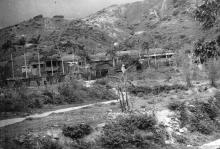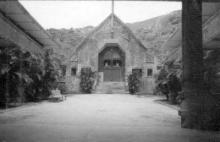Current condition
In use
Hello,
I passed by this interesting collection of old buildings in Ngau Chi Wan (not far from Diamond Hill) recently, and have found out that it is the former St Joseph's Home for the Aged (also used by the Little Sisters of the Poor at one point). It has been slated for redevelopment (retaining the old buildings, but within a large scale new residential/commercial project) for the past decade, although construction works have not yet begun.
I haven't been able to find these buildings on the Gwulo site yet - could anyone please direct me to the right page? If it doesn't exist, I will try to create a new page for it.
Thanks
Elizabeth



Comments
re: Former St Joseph's Home for Aged in Ngau Chi Wan
Hi Elizabeth,
I don't see any information about these buildings on Gwulo, so this can be their page. I've changed it to a "Place" page so it has a map and can connect to the photos.
Regards, David
St Joseph's Home
I heard a rumour that either planning permission hadn't been given or there was a lack of funds for this development - either way it has been sitting in this state for at least the past 2 years or so.
St Joseph's home
Thanks, David.
Phil, that's interesting...maybe it's the latter, as it seems that development consent for the project was given back in 2003 or 2004.
I found a brief description of the site in Wordie's 2007 book, "Streets - Exploring Kowloon", page 268, but it was presumably written before the new development proposal was publicised, as it makes no mention of it and refers to the home as still being used.
Elizabeth
Re: St Joseph's Home
The Little Sisters of the Poor website as seen here gives some information of the origin of the building. The Government's ecclesiastical returns from 1927 in HKGRO indicates the property was known as St. Joseph's Chapel, Home for the Aged.
St. Joseph's Home -- Revolutionary site
The site of St. Joseph's Home has a long and interesting history which is detailed in the publication 保育香港歷史筆記(第三期) in Chinese. The land was owned by CHAN Siu-pak 陳少白 (leader of the Hong Kong branch of Tong Meng Hui -- translated as "Chinese Revolutionary Alliance" or "United League") bewteen 1908 and 1916, and was used by SUN Wei, the elder brother of Dr. SUN Yat-sen, as a farm.
St Joseph's Home
Thank you both for your comments.
I have to admit that the information I've been able to find so far is quite sketchy (have relied mostly on wikipedia), so it is good to have other sources of information. Certainly it seems to be a classic case of the need for sympathetic heritage preservation, and we can only hope that this is achieved for these buildings if/when the development project proceeds.
Elizabeth
On-going
According to public information, the building plans were approved in 2011 and the authority had also given the consent to commence work earlier this year.
The head of Kowloon Development (developer of the site) said in June this year that they are still in negotiation with Government on land premium amount (which was supposed to be upwards of $10b). So I guess until that is settled the construction works would not commence.
The AMO's Historic Building Appraisal
From http://www.aab.gov.hk/form/brief_information_grade2.pdf:
Historic Building Appraisal
St. Joseph’s Home for the Aged - Villa
No. 35 Clear Water Bay Road, Kowloon
Historical Interest
St. Joseph’s Home for the Aged (聖約瑟安老院) was established by the Little Sisters of the Poor (安貧小姊妹會, a French-based charity body) in 1926. The compound of the home at its peak contained more than ten buildings or structures with different construction years. The Villa was originally owned by Mr Chan Keng-Yu (陳賡如), who was Compradore of Douglas Laprik and Co. and one of the Founding Directors of Chinese Chamber of Commerce (華商總會, later known as Chinese General Chamber of Commerce in 1950). The premises were sold to the Little Sisters of the Poor in 1926.
Architectural Merit: Villa
The Villa dates from about 1919. It is a single storey bungalow in simple Neo-Classical colonial style featuring a colonnaded verandah and a raised arched semi-basement for ventilation. The roof is flat but originally may have been a Chinese tiled pitched roof. The front verandah is formed by eight square Doric columns which support the entablature on segmental arches. The entablature has a moulded cornice and a plain parapet wall above. The verandah is served by double entry steps. There are ornamental balustrade panels between the columns and louvred wooden shutters or jalousies to the windows. The plan is symmetrical and is twice reduced in width by indents or offsets on the sides.
Gate House
The Gate House was built in the mid-1930s. It is also in Neo-Classical style resembling a triumphal arch forming an impressive entrance to the site. The front and rear façades feature wide 5-centred arches with moulded architraves and Mannerist keystones and ornamental cartouches in the spandrels. The archways are flanked on either side by coupled pilasters of the Doric Order. The parapet is set above a moulded cornice and has a central tablet on the front façade inscribed ‘JMJ’ which stands for ‘Jesus, Mary & Joseph’, a recurring motto of the Little Sisters. Single storey annexes are built on to either side of the Gate House.
Dormitory
Dormitory A was built in 1932-33. It is a two-storied building in Modernist style featuring a linear plan, horizontal banding, rounded corners and plain round columns known as pilotis. A local adaptation is the Chinese tiled pitched roof. The streamlined balconies and rounded corners are features of the “Liner Style” of the 1930s, so called because of the resemblance to ocean going liners of the period.
Originally, the compound also comprised a St. Joseph’s Chapel and Dormitories B and C which, however, have been demolished.
Authenticity, Rarity, Built Heritage Value & Group Value
The three remaining buildings appear to be authentic with minor alterations and additions. Taken together they form an interesting group with significant built heritage value.
Social Value & Local Interest
Originally the Home had considerable social value being a home for elderly people with no-where to live and no-one to look after them. During the 1930s it served as a refuge for refugees from China fleeing from the Japanese invasion. The Home was the first purpose-built home for the aged in Hong Kong and therefore a pioneer in this field of social services.
Group Value
Nearby the Sham Shan Kwok Wong Temple (三山國王廟) is found.
Adaptive Re-use
The compound is being redeveloped and the three remaining buildings will
be retained and integrated into a commercial/residential development scheme.
1945 St. Joseph's Home for the Aged
These are good to see
Thank you for sharing these, Moddsey.
Liz
1945 Visit: St Joseph's Home for the Aged, Sir Keith & Lady Park
CoastyHK has had an Imperial War Museum film digitised that shows Air Chief Marshall, Sir Keith and Lady Park's visit to Hong Kong.
In the video, the visit to the Home or Convent at Kai Tak was made on 26 October 1945 and can be viewed from 04:17 to 04:42 here
The Home had been requisitioned and served as temporary quarters for the RAF.